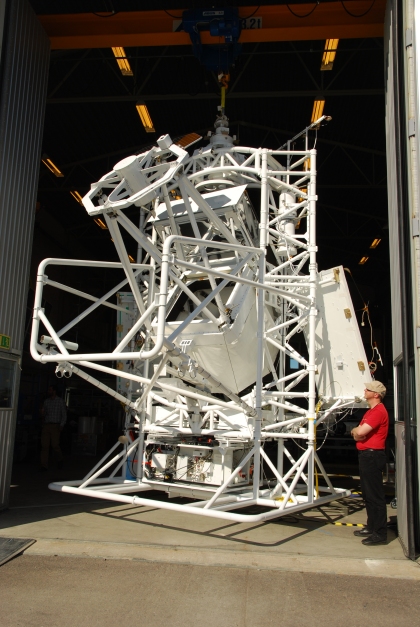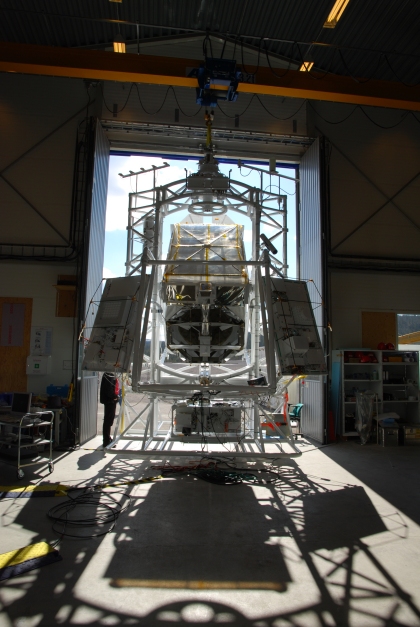
|
Press Release 05/2009
|
 |

|
Press Release 05/2009
|
 |
Press Release 05/2009 - 20th May 2009
The solar observatory ![]() SUNRISE has now looked into the Sun for the first time. Only a few weeks before its launch, the mission led by the Max Planck Institute for Solar System Research (MPS) in Germany has thus reached an important milestone. The solar observatory is scheduled to start on its five day journey around the North Pole from ESRANGE Space Center in Kiruna (Sweden) in the beginning of June. Carried by a huge balloon filled with helium, SUNRISE will observe the SUN from a height of 37 kilometers above the ground and study magnetic structures on the solar surface with an accuracy never achieved before.
SUNRISE has now looked into the Sun for the first time. Only a few weeks before its launch, the mission led by the Max Planck Institute for Solar System Research (MPS) in Germany has thus reached an important milestone. The solar observatory is scheduled to start on its five day journey around the North Pole from ESRANGE Space Center in Kiruna (Sweden) in the beginning of June. Carried by a huge balloon filled with helium, SUNRISE will observe the SUN from a height of 37 kilometers above the ground and study magnetic structures on the solar surface with an accuracy never achieved before.
The mission SUNRISE is unique. The solar observatory, that in the past six years has been designed and constructed by an international team of scientists, will carry the largest solar telescope ever to leave the surface of the Earth. The helium-filled balloon, that will lift the instrument up to a height of 37 kilometers, will expand to a diameter of roughly 130 meters in the upper atmosphere. There, SUNRISE will have left more than 95 percent of the Earth’s atmosphere behind - and its perturbing influence on the telescope’s visual acuity. The scientists therefore expect SUNRISE to discern the finely structured surface of the Sun and the distribution of magnetic fields with a resolution of up to 35 kilometers. This is comparable to distinguishing a single Euro-coin from a distance of 100 kilometers.
Since the beginning of April, the SUNRISE-Team has been preparing for the launch in Kiruna. In the past weeks the scientists have connected the telescope with the other scien-tific instruments using its light. Additionally, the scientific payload has been integrated into the gondola that will later be directly connected to the balloon. Now, the team has achieved another important goal: Through the door of the hall, in which the preparations are taking place, SUNRISE has looked into the Sun without protection for the first time. "This is a moment we have been working towards for six years", says project manager Peter Barthol from MPS.

|
|
The white gondola carries the telescope and additional scientific instruments. SUNRISE has now looked at the Sun for the first time. |
|
(Credits: MPS, P. Barthol) |
A few days before, the scientists had already taken a more careful glance at the Sun. A protective foil prevented the entire sunlight from entering into the telescope. "The telescope bundles the light like a burning glass. However, our burning glass has a diameter of one meter. In the focal point we therefore create high powers on a very small area", explains Barthol. Of course, SUNRISE is equipped with mechanisms to lead away this heat. But if the telescope is not precisely pointed toward the Sun and the light therefore enters in a slanted way, these mechanisms cannot work perfectly. Components of the telescope could then overheat. It is therefore crucial for the solar observatory to orient itself automatically during the flight. Since this process now works reliably on the ground, it was time for an unprotected look at the Sun. In the next days the scientists will now for the first time be able to test their instruments under realistic conditions.
After launch, the mission will continue for approximately five days. Polar winds will grasp the balloon and gondola and blow them westward over the northern Atlantic, Greenland and Canada. In the north of Canada the observatory will land gently carried by a parachute. Since the flight will take place close to midsummer, SUNRISE will be able to observe the Sun continuously. Apart from the telescope, the observatory carries instruments aboard to measure the magnetic fields of the Sun and components to stabilize the system during flight.

|
|
During its first glance at the Sun SUNRISE’s shadow falls in the hall, where the scientists are preparing the mission for launch. |
|
(Credits: MPS, P. Barthol) |
In addition to the Max Planck Institute for Solar System Research several research institu-tions are involved in the mission: the Kiepenheuer-Institute for Solar Physics (Germany), the High Altitude Observatory (Boulder, Colorado), the Instituto de Astrofisica de Canarias (Spain), Lockheed-Martin Solar and Astrophysics Laboratory (Palo Alto, California), NASA’s Columbia Scientific Ballooning Facility, and of course ESRANGE Space Center.
The SUNRISE-project is being funded with help of the German Ministry of Economy and the German Aerospace Center (Grant 50 OU 0401).
Dr. Birgit Krummheuer
Press and Public Relation
Max Planck Institute for Solar System Research
Max-Planck-Straße 2
D-37191 Katlenburg-Lindau
Tel.: +49 5556 979 462
Mobil: 0173 3958625
Email: krummheuer![]() mps.mpg.de
mps.mpg.de
Dr. Peter Barthol
Max Planck Institute for Solar System Research
Max-Planck-Straße 2
D-37191 Katlenburg-Lindau
Email: barthol![]() mps.mpg.de
mps.mpg.de
| © 2009, Max Planck Institute for Solar System Research, Lindau |
Presseinfo 20-05-2009 |